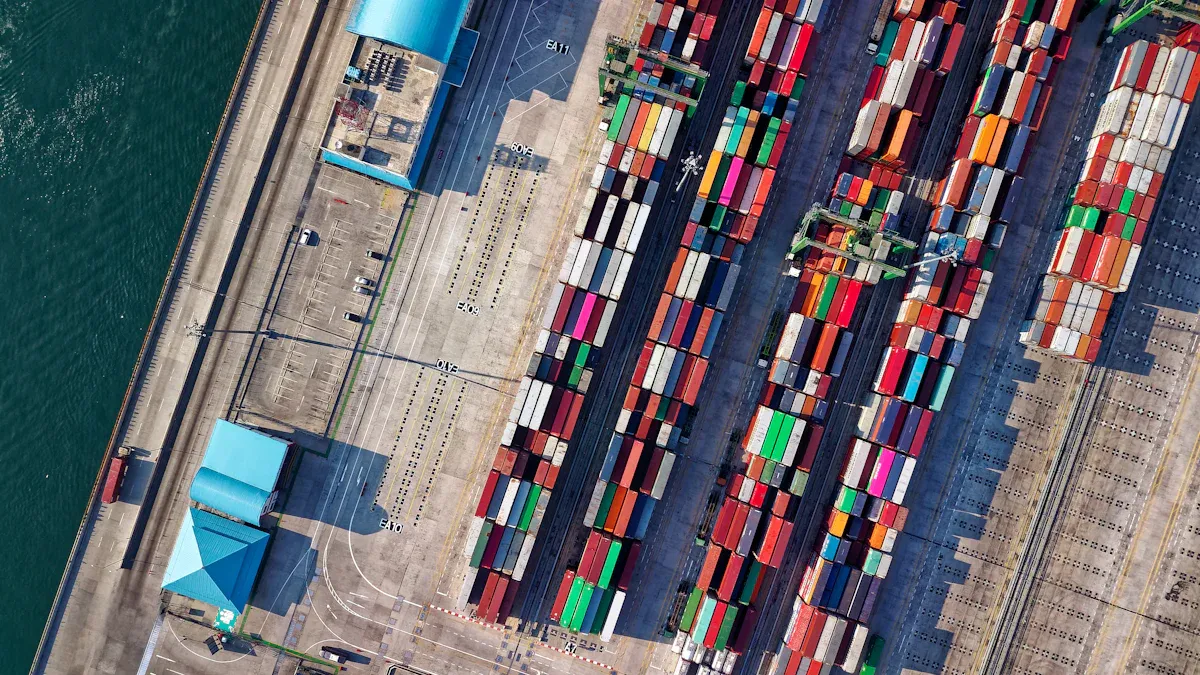Breaking Down the True Cost of Logistics Services in 2025

The logistics industry is growing faster than ever before. In 2022, it was worth $10.41 trillion. By 2028, it may grow to over $14.08 trillion. As it grows, understanding logistics service fees is very important for businesses. Transport costs can make up 60% of all logistics expenses. Hidden shipping fees can cause big problems. Being clear about costs helps control spending and save money.
Key Takeaways
Secret costs in shipping can make prices go up fast. Check freight bills often to stop surprise fees.
Using tools, like JUSDA's tech, helps watch and control shipping costs. This helps you save money and make smarter choices.
Checking shipping bills often can find errors and cut costs. Regular reviews make shipping work better overall.
Common Hidden Costs in Logistics Services

Extra Fees in Freight Rates
Freight rates may seem simple at first. But hidden fees can raise the total cost quickly. Extra charges, like fuel costs or delivery to homes, are common. Fuel fees change with market prices, making costs hard to predict. Also, fewer drivers (one driver for nine job openings) add more fees. These extra charges can increase your logistics bill a lot. Always check freight invoices closely to avoid surprises.
Mistakes in Invoices and Their Effect on Costs
Errors in freight invoices can cause surprise costs. Manual data entry often leads to mistakes, like wrong addresses or dates. For example, one company marked the wrong shipping date. This caused delays and unhappy customers. Fixing errors, like wrong addresses, can cost $20 to $125 per shipment. These mistakes not only cost money but also hurt customer trust.
Surprise Accessorial Charges
Accessorial charges are extra fees that can catch you off guard. These include detention fees, stop-off charges, and unused truck fees. For instance, detention fees are about $60 per hour. A stop-off fee for the first stop is usually $100. These charges are often missed in freight quotes. If ignored, they can make shipping much more expensive.
Customs and Rules in Global Shipping
Global shipping has tricky customs and rules to follow. Changes in shipment rules or new taxes, like in Switzerland in 2025, can raise costs. Products under strict rules, like FDA-regulated items, need extra care. Mistakes can lead to relabeling or even destroying goods, which costs a lot. These hidden costs can mess up your supply chain if not handled well.
Costs from Bad Infrastructure
Bad infrastructure can cause delays and extra costs in shipping. Poor roads, crowded ports, and bad facilities slow things down. For example, ocean freight is only 30% of supply chain costs. Ignoring other parts, like transport and storage, can raise total costs. Managing infrastructure well helps avoid these hidden costs and keeps things running smoothly.
The Impact of Hidden Costs on Logistics Service Fees
How Hidden Shipping Costs Affect Finances
Hidden shipping costs can make logistics much more expensive. These costs are often unnoticed, making them hard to track. For example, Maersk found 10-12% of invoices had mistakes. These errors caused a 1.5-2% rise in freight spending. Charges like detention fees can quietly add up over time. Using automated audits can help find and fix these hidden fees. Fixing these issues helps control costs and avoid surprises.
Problems from Poor Cost Management
Bad cost management can mess up logistics operations. High shipping costs can lower profits in tough markets. Delays from extra fees or bad planning upset customers. Teamwork is needed to spot problems in logistics processes. Without teamwork, problems grow, making costs harder to control. This can also slow down operations.
How Hidden Costs Hurt Customers
Hidden costs can make customers unhappy. Delays and surprise fees often mean late deliveries. Higher shipping costs may force you to raise prices. This can push customers to choose other companies. Being honest about shipping costs builds trust with customers. Clear pricing helps keep customers loyal.
Long-Term Dangers for Business Profits
Ignoring hidden costs can hurt your business over time. These costs can pile up and limit money for growth. High logistics fees make it hard to compete on price. Bad cost management can also harm your reputation. Fixing hidden costs early protects profits and helps your business grow.
Strategies to Find and Reduce Hidden Costs
Using Technology for Clear Costs with JUSDA
Technology helps find hidden shipping costs. JUSDA's tools show real-time logistics expenses. This helps track and manage costs better. The JusLink platform uses IoT, cloud computing, and big data. It improves visibility, reduces mistakes, and ensures correct billing.
Metric | What It Means |
|---|---|
Gives quick updates and answers questions to keep clients informed. | |
Flexibility and adaptability | Handles schedule changes and demand shifts without problems. |
Performance metrics and KPIs | Tracks and improves performance to meet goals. |
Technological integration | Works with client systems to boost efficiency and cut errors. |
Using these tools lowers extra fees and finds hidden costs. This helps save money and improve profits.
Lowering Freight Rates by Negotiating Contracts
Good contract talks can cut freight rates. Use past shipping data to show your needs. Promise steady shipping volumes for better deals. Research market rates to compare prices. Offer carriers long-term contracts to build trust. Negotiating during slow seasons often gets lower rates. These tips help get fair prices and save money.
Checking Bills Often to Spot Hidden Costs
Regular checks find and fix hidden costs. Billing mistakes, like wrong fuel fees, raise costs. Audits make costs clear and improve transport management. For example:
Save money by fixing overcharges.
Fix errors to make shipping smoother.
Use data to make better choices.
Sticking to audits saves money and improves processes over time.
Working with Trusted Providers like JUSDASR
Trusted providers like JUSDASR make logistics easier. They offer clear pricing and fast services. Their AI tools give real-time market updates for smart decisions. Warehouses in key spots and FedEx partnerships cut costs. This teamwork reduces hidden fees and boosts efficiency.
Teaching Teams to Handle Hidden Costs
Training helps teams find and manage hidden costs. Skilled workers make fewer mistakes and work faster. Training investments bring benefits like better cash flow and profits. Handling resistance to change and gaining support are important for success.
Future Trends and Emerging Hidden Costs in Logistics

Sustainability-Related Costs in Logistics Service Fees
Sustainability is now a big focus in logistics. Governments want greener practices, which can raise logistics service fees. For example, new rules need carriers to use cleaner tech. These changes often make shipping more expensive. The IMO’s sulfur cap forced carriers to use low-sulfur fuel. This increased costs by up to 50% for some shipments. Electric vehicles and renewable energy are also becoming popular. While they cut carbon footprints, they cost a lot to start using.
Tip: Work with providers like JUSDA, who focus on sustainability, to manage these costs better.
Technological Advancements and Their Cost Implications
Technology is changing logistics but adds new expenses. Companies like CMA CGM use AI to plan better shipping routes. This helps lower transport costs. DHL uses big data to predict demand and avoid delays. But using these technologies needs big investments.
Technology | How It Affects Costs and Efficiency |
|---|---|
Real-time tracking systems | Improves delivery and makes operations clearer. |
Automated sorting facilities | Boosts efficiency and cuts labor costs. |
IoT and AI | Plans better routes and improves supply chain tracking. |
Electric vehicles | Lowers carbon output and supports green goals. |
The big data market in logistics is growing fast. It may grow over 21.5% yearly through 2032. While tech saves money later, it can first raise costs.
Evolving Regulatory and Compliance Fees
Rules are always changing, and following them can be pricey. New trade rules, fuel taxes, and safety standards raise freight costs. For example, tariffs on cross-border shipping increase delivery prices. Green rules also add costs as companies meet emission goals.
Factor | How It Affects Costs |
|---|---|
Fuel taxes | Higher diesel taxes raise fleet expenses. |
Sustainability rules | Meeting emission goals adds extra costs. |
Safety regulations | Needs spending on better tools and training. |
Trade policies | Tariffs increase cross-border shipping costs. |
Keeping up with these rules helps avoid surprise fees and control costs.
Rising Final-Mile Costs in E-Commerce Logistics
The final mile is the priciest part of logistics. Labor shortages are making costs higher. In March 2022, 11.3 million U.S. jobs were unfilled. Delivery drivers often take many trips, slowing things down. Customers now expect fast, free delivery, like Amazon Prime offers. This puts more pressure on logistics budgets. These issues raise freight rates and hidden e-commerce costs.
Note: Using smart last-mile solutions, like JUSDASR’s warehouses and FedEx partnerships, can help manage these costs.

JUSDA Solutions
To provide you with professional solutions and quotations.
Finding and controlling hidden logistics costs is very important. You can save money by using smart methods.
Work with trusted partners to make processes smoother.
Use tech tools to track and fix problems quickly.
Plan better routes often to cut travel costs.
Teams that work well grow 58% faster. Poor teamwork wastes time and limits progress. Staying organized leads to better outcomes and lasting success.
